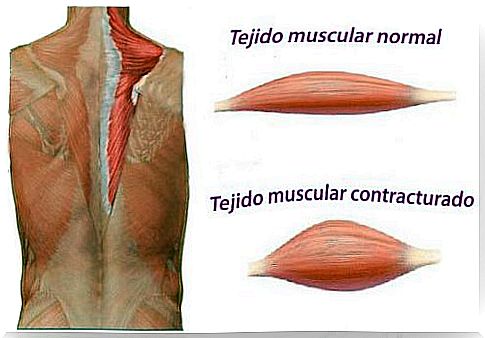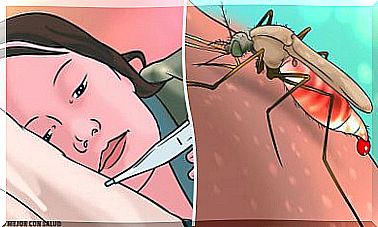5 Tips To Get Rid Of A Contracture
A contracture is the involuntary contraction of one or more muscles in any part of the body and is usually located in the cervical area (neck), shoulders, dorsal area (shoulder blades) and lower back.
A contracture can cause immobility of the affected area, discomfort and pain to the sufferer. However, eliminating a contracture is an easy job as long as the methods of doing it are known.
So, if you were looking for a way to relieve contractures quickly and effectively, in this article you will find more than one answer, do not miss it!
What exactly is a contracture?

In a normal state, a muscle contracts and stretches, but in some cases, it cannot relax and remains contracted. A contracture is an involuntary muscle contraction, resulting in a bulge, also known as a knot. The area remains hard and swollen.
This contraction reduces movement and can be very painful. In addition, it can affect adjacent muscles, creating more contractures, in a vicious cycle.
To stop this situation and alleviate this pain, we must undo the contracture.
What are the causes of contracture?
Contractures can appear due to various causes, such as sedentary lifestyle and postural statism, as well as somatizations (derived from stress or anxiety) and the following:
- Trauma
- Sudden movements.
- Overexertion when trying to do an exercise (without having warmed up before) or lifting a heavy object.
On the other hand, insufficient water intake and an inadequate diet, among other bad lifestyle habits, can contribute to the appearance of various discomforts, including a contracture.
It is interesting to know that the deficiency of some essential minerals (such as magnesium) is also associated with muscle discomfort.
How to relieve a contracture?
Although there are specific medications for the treatment of contractures, such as prescription muscle relaxants, we can promote their relief by applying very simple methods.
Of course, these measures should not replace the medications or the recommendations suggested by the professional. In any case, they can be a complement to the prescribed treatment.
1. Don’t strain the muscle
The first thing you should do when suffering a contracture is to avoid straining the muscle or the affected area. Therefore, try to perform the movements smoothly and keep some rest as much as possible. This way, you will avoid causing more damage than already exists.
This measure should be maintained until the muscle recovers completely. Likewise, you should avoid forced labor, activities with high physical impact or any type of muscular overexertion.
2. Do some stretching

It is essential to practice some stretches every day, not just when you want to avoid a contracture (or when you already have one). Of course, you should always do them gently and slowly, to avoid further complications.
If your doctor has already evaluated you and has indicated what may be the best stretches for you, follow his advice. On the other hand, if you have doubts, consult with the physiotherapist.
2. Hot water
Hot water compresses and showers can help relieve pain and other discomfort if you have a contracture. In addition, they help to relax the body in general lines, which is very pleasant.
Therefore, to reduce the discomfort of the contracture, you can apply a hot compress for a few minutes, several times a day.
3. Application of rosemary and clay
Just as hot compresses can help relieve muscle pain or a tightness, some poultices and ointments are also thought to be helpful.
An example of this is the mixture of rosemary and clay, to which anti-inflammatory, relaxing and antispasmodic properties are attributed .
Ingredients
- 4 tablespoons of rosemary (50 g).
- 200 grams of white clay.
- 1 glass of water (250 ml).
Preparation
- In a pot pour the water and the rosemary.
- Put on the fire and boil for 10 minutes.
- Let stand for 20 minutes.
- Transfer the liquid together with the rosemary to a plastic container.
- Add the clay and mix it perfectly until there are no lumps.
- Let it sit for a couple of hours at least.
How to use
- First, apply the mixture directly on the affected area.
- Leave on for 20 minutes.
- Next, rinse with hot water.
- Repeat 2 times a day.
- For best results, we recommend applying natural rosemary oil after removing the mixture.
Note: it is important not to use metallic objects to make the preparation, because they could alter the properties of the clay.
5. Chamomile

Another remedy that can help you in case of a muscle contracture or discomfort is the classic chamomile infusion. It has anti-inflammatory, antispasmodic, relaxing and slightly sedative properties.
Be careful, the infusion of chamomile will not eliminate the pain of the contracture by itself, but it can contribute to the relief and relaxation of the body. Consume it with a touch of honey if you wish or a few drops of lemon.
How to avoid a contracture?
To avoid contractures, it is recommended that you take care of some habits on a daily basis. Let’s go over some of the most important ones below:
- Avoid straining the muscle and rest if it is weakened.
- Exercise regularly, always warming up and stretching beforehand.
- Always maintain good posture, not just when exercising or doing sports.
- Maintain a balanced diet and good hydration.
- You try to manage your thoughts and emotions to avoid somatizations in the back and other areas of the body.
If you consider that you have a contracture or any other similar problem, consult your doctor and follow their instructions. Also, you can consider going to the physical therapist.









